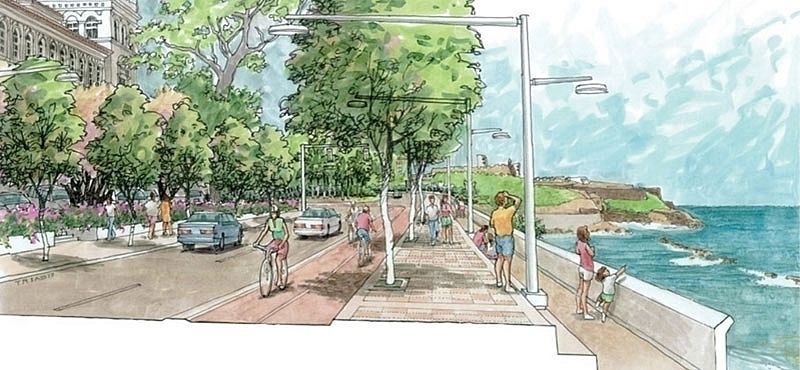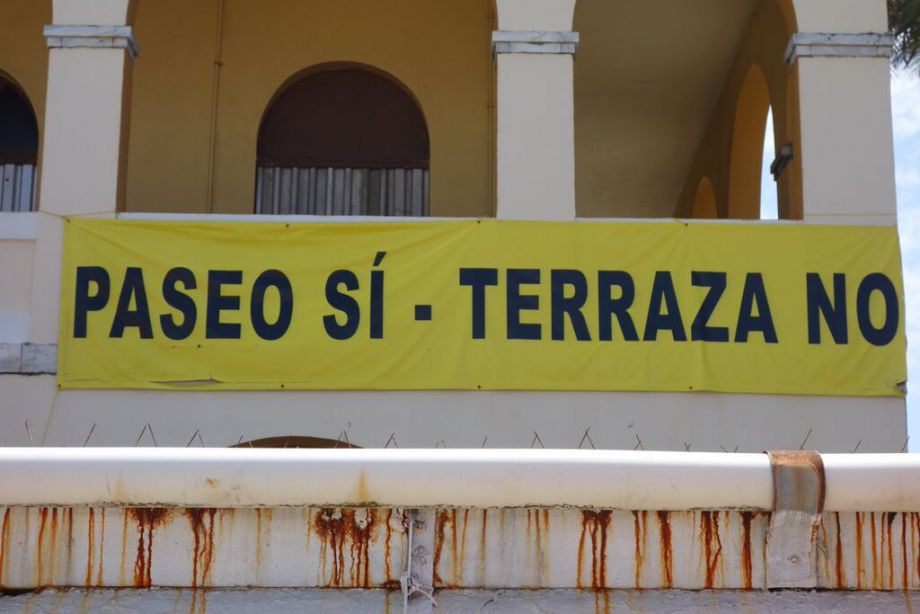“Mi corazón se quedo frente al mar en mi viejo San Juan (My heart remains facing the sea in my Old San Juan),” go the lyrics to the 1942 crooner’s classic “Mi Viejo San Juan,” the official song of the Puerto Rican capital. But if the island’s current government gets its way, there will be one less ocean view from Old San Juan in the near future.
Bulldozers are already breaking ground at the Paseo de Puerta de Tierra, a waterfront infrastructure project and commercial development. It prompted a landmark lawsuit last month as a citizens’ group seeks to derail the project over environmental and archaeological concerns.
Civic leaders have been building on the San Juan coastline since the Spanish founded the city in 1521. Nowadays, the city’s mainland waterfront is chockablock with beachfront hotels. La Isleta, the small island jutting into the ocean where the city first developed, is ringed by seaside promenades and imposing military edifices, which are part of a UNESCO World Heritage Site managed by the National Park Service. Almost 500 years later, the city has come down to the final undeveloped strip: one mile between a beachfront public park and the Puerto Rican capitol building.
“The view here of the ocean and the castle [Fortaleza de San Cristóbal] as you come into Old San Juan is iconic,” says Michy Marxuach, an art curator who lives nearby. She is part of the opposition and took me on a tour of the site.

Construction has started on Paseo de Puerta de Tierra, a waterfront infrastructure project and commercial development on San Juan’s final undeveloped oceanside strip.
The construction crews showed up last fall, according to activists, and on December 30th — not exactly the best time to capture public attention — the island government presented renderings for a bike lane and pedestrian promenade that just happened to have 24,000 square feet of commercial real estate attached. Called La Terraza (The Terrace), the development calls for high-priced bars and restaurants. A federal TIGER grant fell through, leaving the cash-strapped Puerto Rican government on the hook for $25 million to develop the city-owned site.
Cindy Golbert is a resident of Old San Juan who attended one of the follow-up public meetings. “We realized something was up when the public officials answered our questions as though it was already a done deal,” she says. “And when we pressed them on how many square feet of commercial there would be, they kept changing the number.” What’s more, the project was not included in the most recent four-year investment plan (PICA in its Spanish acronym) of the Puerto Rico Planning Board, which would be expected of a proposal with such a high price tag.
Other nearby residents balked at the fast-tracked project, a rarity in red tape-prone Puerto Rico. They coalesced under the banner Paseo Para Todos with the slogan “Paseo Sí, Terraza No,” (Promenade for All: Paseo Yes, Terraza No) — in favor of improved pedestrian and cyclist amenities but opposed to a commercial development that would replace palm trees with concrete.
In late May, they filed a lawsuit alleging improper public consultation, failure to conduct impact assessments, and anticipated environmental and archaeological damage to the fragile cliffs and remnants of the colonial city’s third line of defensive walls. It marked one of the first times that Puerto Rican citizens have filed a cease-and-desist claim against their own government.
“The commercial use conceded to La Terraza constitutes a land use violation because it is a dedicated green zone, as in open areas, plazas, sidewalks,” says Pedro Saadé, a lawyer who spoke at a Paseo Para Todos meeting on June 1st. “The requested solution is for the courts to deny the permits. We are requesting the suspension of La Terraza.”
A spokesperson for the governor’s office did not respond to inquiries about Paseo Para Todos’ allegations or the lawsuits, but the Institute of Puerto Rican Culture, a public agency responsible for cultural heritage, did address some of the issues.
“The Institute of Puerto Rican Culture believes that the project will not impact on the area’s historic vista of the area, and in fact will support enhanced opportunities to appreciate the historic heritage,” says Laura del Olmo, director of archaeology and ethnohistory, citing proposed viewpoints and historic markers. She calls La Terraza “a plaza with low-impact commercial establishments.”
Del Olmo also affirmed that archaeologists have worked on site to catalogue any discoveries, including remnants of brick and masonry military pavilions from as far back as the mid-19th century. “So far no archaeological materials or structures have been destroyed and we don’t expect that to happen,” she says.
Marxuach remains nonplussed. It took retroactive legislation to put the Paseo in the PICA, a move she calls “legalizing the illegal.” But if citizen activism has a successful day in court, Paseo Para Todos may be singing “Mi Viejo San Juan” in celebration.
The Works is made possible with the support of the Surdna Foundation.

Gregory Scruggs is a Seattle-based independent journalist who writes about solutions for cities. He has covered major international forums on urbanization, climate change, and sustainable development where he has interviewed dozens of mayors and high-ranking officials in order to tell powerful stories about humanity’s urban future. He has reported at street level from more than two dozen countries on solutions to hot-button issues facing cities, from housing to transportation to civic engagement to social equity. In 2017, he won a United Nations Correspondents Association award for his coverage of global urbanization and the UN’s Habitat III summit on the future of cities. He is a member of the American Institute of Certified Planners.












